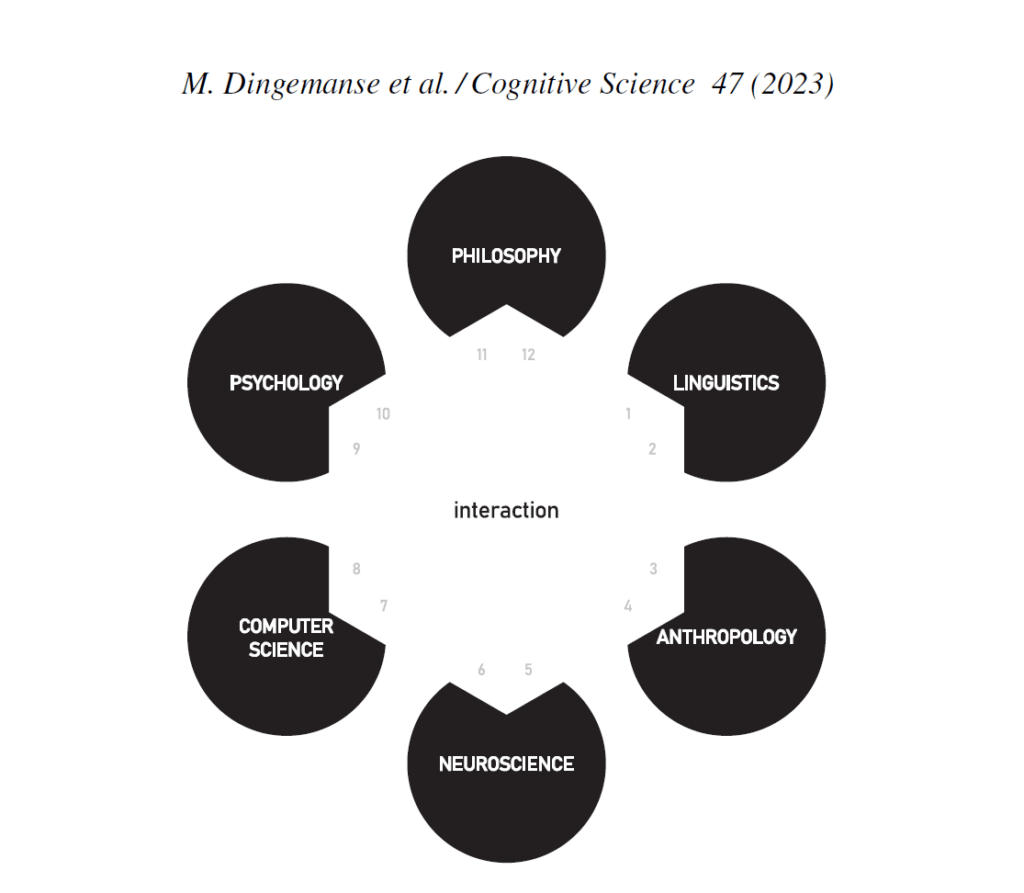
Here’s the paper: “Beyond Single-Mindedness: A Figure-Ground Reversal for the Cognitive Sciences.”
Dingemanse et al_2023_Beyond Single-MindednessThey go on to describe this new viewpoint as a “figure-ground reversal that puts interaction at the heart of cognition“. Mark Dingemanse explains and illustrates the deliberate use of “figure-ground” as follows:
“Why a figure-ground reversal rather than a ‘paradigm shift’ or an ‘interactive turn’? This is both a nod to the roots of cognitive science and a rhetorical choice: we think of the interactive stance as a perspective — a way of seeing that deserves to be a key part of the conceptual toolkit of cognitive scientists
Is there a hexagon below, or whitespace bounded by circular sectors? Gestalt switches are reversible, but hard to unsee. We want to make interaction ‘hard to unsee’ for @cogsci.”

For more details, check out Dingemanse’s website: Beyond Single-Mindedness.
Interaction is at the heart of cognition—and events!
For decades I’ve been designing meetings that support meaningful interaction to create successful learning and connection. Sadly, integrating interaction into meeting sessions is still the exception rather than the rule at most meetings, which are places where learning is restricted to listening to experts lecturing, and connecting around relevant content is relegated to hallways, meals, and socials.
Such traditional meeting models are based on cognitive learning as something that is done to a set of individual brains.
So I’m heartened to see scientists adopting a view of cognition as something that arises through interactions between people. And it doesn’t surprise me. After all, as the paper points out:
“A fundamental fact about human minds is that they are never truly alone: all minds are steeped in situated interaction.”
—Mark Dingemanse et al, Beyond Single-Mindedness: A Figure-Ground Reversal for the Cognitive Sciences, Cognitive Science, January 10, 2023
I continue to believe that interaction around meaningful content is at the heart of events. And now there’s a little extra scientific support as well!


Adrian, I was excited to read this! We sometimes talk about the transfer of knowledge at events, but not so much about how through interaction, participants actually produce knowledge, or in the words of this paper, “co-constitute cognition.” A book I can’t recommend too highly is “The Extended Mind: The Power of Thinking Outside the Brain,” by Annie Murphy Paul. One fascinating thing she writes about is how the perception that we think on our own has been reinforced by the physical limitations of fMRI, which measures individual brain activity. New technology w which allow scientists to scan multiple brains at one time are revealing these different neural and cognitive processes when people think together.
Barbara, thank you so much for the information you shared! I checked out Paul’s book’s reviews, and it looks like she’s covering many aspects of the power of social and embodied learning that I and others have been writing about for quite a while.
As you (and the paper I mentioned in this post) point out, brain-activity-focused research on learning has been limited to individual brains. Personally, I think it’s more illuminating to study how we learn via experiments on group learning and problem-solving process. But I’ve no objection to research using simultaneous multi-brain scanning of learners, and I’m interested to see what this work discovers.